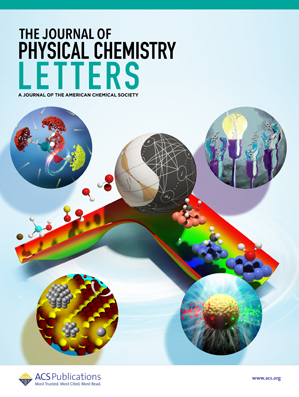金属- tmdc接触中表面静电电位差的原子尺度起源和屏蔽校正偶极子预测
IF 4.8
2区 化学
Q2 CHEMISTRY, PHYSICAL
引用次数: 0
摘要
金属-半导体接触中表面静电电位差(ΔV)的原子尺度起源和定量描述仍然难以捉摸,限制了合理的界面势垒设计。通过对Au/Ag/Pt/ pd -过渡金属二硫化物(TMDC)触点的第一性原理计算,我们建立了ΔV与由原子序数(Z)、价电子数和原子半径参数化的屏蔽校正偶极子项之间的鲁强线性相关性。本文确定了三个关键的见解。首先,来自金属- TMDC和TMDC - TMDC界面以及TMDC层的偶极子项在线性上占主导地位,贡献约为90%-92%。其次,由于金属自由电子区的抑制,靠近金属层的界面层和TMDC层的贡献减小。第三,结合高z原子屏蔽修正,线性度提高了8%-10%,最大修正来自金属- tmdc界面。利用这种相关性,预测了与带结构相匹配的界面势垒。这项工作澄清了ΔV的原子起源,并为设计金属- tmdc接触屏障建立了预测框架。本文章由计算机程序翻译,如有差异,请以英文原文为准。

Atomic-Scale Origins and Shielding-Corrected Dipole Predictions of Surface Electrostatic Potential Difference in Metal–TMDC Contacts
The atomic-scale origins and quantitative description of the surface electrostatic potential difference (ΔV) in metal–semiconductor contacts remain elusive, limiting rational interface barrier design. Through first-principles calculations on Au/Ag/Pt/Pd-transition-metal dichalcogenide (TMDC) contacts, we establish a robust linear correlation between ΔV and shielding-corrected dipole terms parametrized by atomic number (Z), valence electron count, and atomic radii. Three critical insights are identified. First, the dipole terms from metal–TMDC and TMDC–TMDC interfaces as well as TMDC layers dominate linearity with a contribution of about 90%–92%. Second, the interfaces and TMDC layers in closer proximity to the metal layer show reduced contributions due to suppression by the metallic free-electron region. Third, incorporating high-Z atomic shielding corrections collectively enhances linearity by 8%–10%, with a maximal correction from metal–TMDC interfaces. Using this correlation, interface barriers are predicted, matching those from band structures. This work clarifies the atomic origins of ΔV and establishes a predictive framework for designing metal–TMDC contact barriers.
求助全文
通过发布文献求助,成功后即可免费获取论文全文。
去求助
来源期刊

The Journal of Physical Chemistry Letters
CHEMISTRY, PHYSICAL-NANOSCIENCE & NANOTECHNOLOGY
CiteScore
9.60
自引率
7.00%
发文量
1519
审稿时长
1.6 months
期刊介绍:
The Journal of Physical Chemistry (JPC) Letters is devoted to reporting new and original experimental and theoretical basic research of interest to physical chemists, biophysical chemists, chemical physicists, physicists, material scientists, and engineers. An important criterion for acceptance is that the paper reports a significant scientific advance and/or physical insight such that rapid publication is essential. Two issues of JPC Letters are published each month.
 求助内容:
求助内容: 应助结果提醒方式:
应助结果提醒方式:


